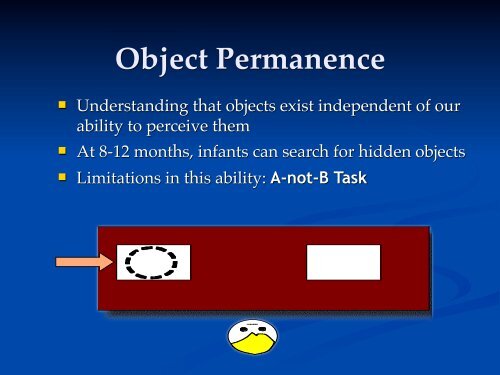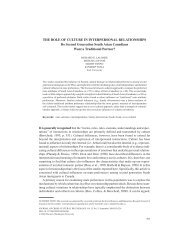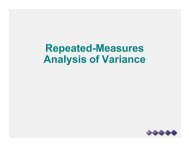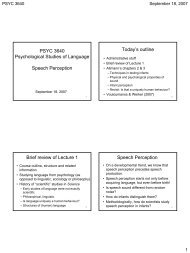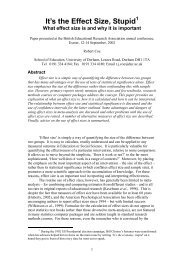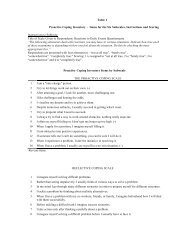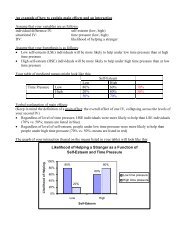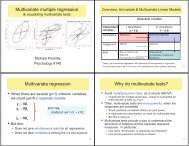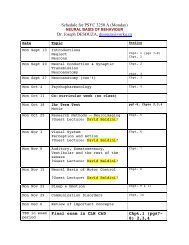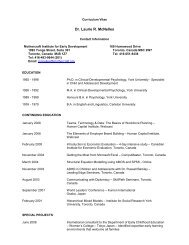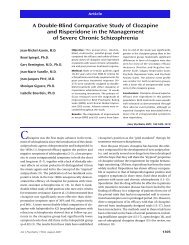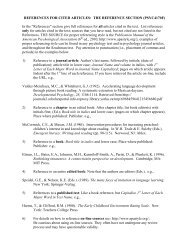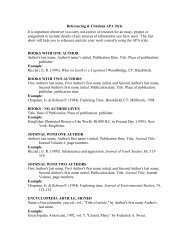Object Permanence
Object Permanence
Object Permanence
You also want an ePaper? Increase the reach of your titles
YUMPU automatically turns print PDFs into web optimized ePapers that Google loves.
<strong>Object</strong> <strong>Permanence</strong><br />
<br />
<br />
<br />
Understanding that objects exist independent of our<br />
ability to perceive them<br />
At 8-12 months, infants can search for hidden objects<br />
Limitations in this ability: A-not-B Task
<strong>Object</strong> <strong>Permanence</strong><br />
<br />
<br />
<br />
Understanding that objects exist independent of our<br />
ability to perceive them<br />
At 8-12 months, infants can search for hidden objects<br />
Limitations in this ability: A-not-B Task
<strong>Object</strong> <strong>Permanence</strong><br />
<br />
<br />
<br />
Understanding that objects exist independent of our<br />
ability to perceive them<br />
At 8-12 months, infants can search for hidden objects<br />
Limitations in this ability: A-not-B Task
<strong>Object</strong> <strong>Permanence</strong><br />
<br />
<br />
<br />
Understanding that objects exist independent of our<br />
ability to perceive them<br />
At 8-12 months, infants can search for hidden objects<br />
Limitations in this ability: A-not-B Task
12-18 months<br />
Trial-and-error experimentation of the<br />
world to find new and different ways of<br />
acting on it.<br />
Before this, the infant produces known<br />
actions that will produce mostly known<br />
outcomes
12-18 months<br />
Here the infant produces new actions<br />
and observes the effects<br />
Can do the A-not-B task but only when<br />
object is visibly displaced<br />
Indicates that the spatial relation of objects<br />
relative to other objects is represented and<br />
is not related to their actions
Factors<br />
Revolve around issues of informationprocessing<br />
Visual Attention<br />
Perception<br />
Memory<br />
Perceptual-Action Coupling
Memory<br />
Diamond (1985)<br />
If no delay between hiding and allowing<br />
infant to search, then infants search correctly<br />
If impose a delay, then get errors of searching<br />
at B<br />
2 sec at 7.5 months<br />
Increasing by approximately 2 sec each month
Memory<br />
Lesions to adults’ prefrontal cortex, an area<br />
involved in working memory, results in poor<br />
performance on A not B task<br />
Butterworth (1977)<br />
Used transparent occluders<br />
Found infants still make error<br />
So, it is not just a memory issue
Attention<br />
Maybe they just are not paying attention<br />
where it is hidden<br />
Could affect ability to remember<br />
Horobin & Acredolo (1986)<br />
3 conditions to test for how attention might<br />
relate to ability to search
Horobin & Acredolo<br />
1) Close Pair (15.25 cm)<br />
2) Far Pair (45.75 cm)<br />
3) Six Hole (A and B 45.75 cm apart, with 4<br />
holes in between)
Horobin & Acredolo Results<br />
Condition<br />
Correct Search at B<br />
1 - Close Pair 57%<br />
2 - Far Pair 89%<br />
3 - Six Hole 52%
Horobin & Acredolo Results<br />
Condition<br />
Attention to<br />
B only<br />
Attention to<br />
other<br />
1 - Close Pair 93% 24%<br />
2 - Far Pair 100% 80%<br />
3 - Six Hole 83% 28%
Horobin & Acredolo Results<br />
Condition<br />
Attention<br />
Back to A<br />
Attention to<br />
other<br />
1 - Close Pair 11% 79%<br />
2 - Far Pair 62% 98%<br />
3 - Six Hole 17% 100%
Transparent Occluders<br />
Because infants were found to make errors with<br />
these, memory was ruled out as sole source of<br />
errors<br />
Yates & Bremner (1988) suggest perhaps it is<br />
due to novelty of transparent occluders
Yates & Bremner<br />
Compared familiarizing infants to the<br />
occluders for 5-10 minutes to not<br />
familiarizing them<br />
Found: Familiarized - 10% made errors;<br />
Unfamiliarized - 40% made errors<br />
So memory, or more likely attentioninduced<br />
memory issues, may play an<br />
important role in this error
A not B Task Concerns<br />
There is concern that performance in A-not-B<br />
task is strongly influenced by the development<br />
of motor control<br />
Younger infants have poorer motor control, therefore<br />
make more errors<br />
So use task that does not require motor response<br />
Purpose of Ahmed & Ruffman (2000)<br />
Use violation of expectation paradigm
Other Work on <strong>Object</strong><br />
<strong>Permanence</strong><br />
Bower (1966, 1967, 1982)<br />
Even infants as young as 20 days old see the<br />
bottom left alternative (no ball) as surprising
<strong>Object</strong> <strong>Permanence</strong><br />
Baillargeon (1987)<br />
Found that not until<br />
4.5 months of age<br />
(substage 3) did<br />
infants increase<br />
attention to the<br />
impossible event
Ahmed & Ruffman<br />
3 tasks:<br />
1) Classic A not B task;<br />
2) A not B nonsearch task (using violation of<br />
expectation);<br />
3) one location nonsearch task
Ahmed & Ruffman
Ahmed & Ruffman<br />
Found that infants looked longer at the<br />
impossible appearance of toy at A after<br />
being hidden at B<br />
There was no affect of delay or age<br />
There was affect of age and delay on classic A<br />
not B task<br />
If infants did not have to search, they<br />
were found to remember even after 15s<br />
delay where toy had been hidden<br />
Go back to possibility that get effects due to<br />
attention wandering back to A


